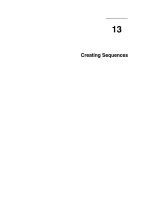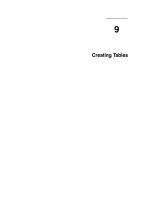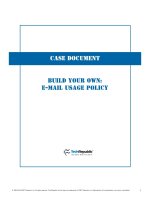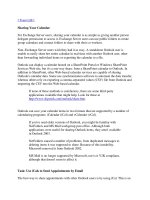Tài liệu Creating Your Application doc
Bạn đang xem bản rút gọn của tài liệu. Xem và tải ngay bản đầy đủ của tài liệu tại đây (20.29 KB, 6 trang )
Creating Your Application
As an example, you are going to create an application that allows a user to input and
display details for members of the Middleshire Bell Ringers Association, an esteemed
collection of the finest campanologists. Initially you will keep the application very
simple, concentrating on laying out the form and making sure that it all works. In later
chapters, you will provide menus and learn how to implement validation to ensure that
the data that is entered makes sense. The following graphic shows what the application
will look like after you have completed it. (You can see the completed version by running
BellRingers.exe, located in the \Microsoft Press\Visual CSharp Step by Step\Chapter
20\BellRingers Complete\BellRingers\bin\Debug folder in your My Documents folder.)
Creating a Windows Forms Application
In this exercise, you'll start building the Middleshire Bell Ringers Association application
by creating a new project, laying out the form, and adding Windows Forms controls to
the form. Because you have been using existing Windows Forms applications in
Microsoft Visual Studio 2005 in previous chapters, much of the first couple of exercises
will be a review for you.
Create the Middleshire Bell Ringers Association project
1. Start Visual Studio 2005.
2. On the File menu, point to New, and then click Project.
3. In the Project Types pane, select Visual C#.
4. In the Templates pane, select Windows Application.
5. In the Name text box, type BellRingers.
6. In the Location list box, navigate to the Microsoft Press\Visual CSharp Step by
Step\Chapter 20 folder in your My Documents folder.
7. Click OK.
The new project is created and contains a blank form called Form1.
Set the properties of the form
1. Select the form in the Designer View window. In the Properties window, click the
(Name) property, and then type MemberForm in the (Name) text box to change
the name of the form. (If the Properties window is not displayed, click Properties
Window on the View menu, or press F4.)
2. In the Properties window, click the Text property, and then type Middleshire Bell
Ringers Association – Members, to change the text in the title bar of the form.
3. In the Properties window, click the BackgroundImage property, and then click the
Ellipses button in the adjacent text box.
The Select Resource dialog box opens.
4. In the Select Resource dialog box, click Local resource and then click Import.
The Open dialog box opens.
5. In the Open dialog box, navigate to the \Microsoft Press\Visual CSharp Step by
Step\Chapter 20 folder in your My Documents folder, select the Bell.gif file, and
then click Open.
Part of the image will be displayed in the Select Resource dialog box.
6. In the Select Resource dialog box, click OK.
The BackgroundImage property is now set to the bell image.
7. In the Properties window, click the BackColor property, and then click the down-
arrow button in the adjacent text box.
A dialog box opens.
8. On the System tab of the dialog box, click Window. This value sets the
background color of all the controls that you drop onto the form to the same color
as the window itself.
9. Select the Font property. This is a composite property that has many attributes. In
the Properties window, click the plus sign (+) to expand the Font property and
display the attributes. Type 12 for the Size attribute of the font, and set the Bold
attribute to True.
TIP
You can also change some composite properties, such as Font, by clicking the
ellipses button that appears when you select the property. When you click the
ellipses button in the Font property, the standard Font dialog box opens and allows
you to select the font and effects that you want.
10. Change the form's Size property, which is also a composite property. In the
Properties window, click the plus sign (+) to expand the Size property and display
the attributes. Set the Width attribute to 600 and the Height attribute to 470.
The form should look like the image in the following graphic.
11. On the Build menu, click Build Solution.
The form should build successfully.
12. On the Debug menu, click Start Without Debugging.
The application will start running and will display the main form containing the
image. The form does not do anything useful yet, so close it and return to Visual
Studio.
How a Windows Forms Application Runs
A Windows Forms application can comprise any number of forms—you can add
additional forms to an application by using the Add Windows Form command on the
Project menu in Visual Studio 2005. How does an application know which form to
display when an application starts?
If you look in the Solution Explorer, you will see another file called Program.cs. You can
right-click this file and select View Code to display its contents in the Code And Text
Editor window. This file contains the Main method, defining the entry point for the
application. The key statement in this method is:
Application.Run(new MemberForm());
This statement creates a new instance of MemberForm and displays it. When the form
closes, the Application.Run statement terminates, and as this is the final statement in
Main, the program exits.
TIP
If you have previously developed applications using Visual Basic 6, you will know that
in that application, you can designate a form as the default form; this form is displayed
automatically when the application starts. There is no such option in Visual Studio 2005.
If you want to change the form that a .NET Framework application runs when an
application starts, edit the Application.Run statement in the Main method.
You should only use the Application.Run statement for displaying the initial form for an
application. If you have defined additional forms, you can display them from your own
code, typically in an event handler, using the Show method inherited by all Windows
Forms objects. For example, if you have added another form called AnotherForm to your
application, you can display it like this:
AnotherForm aForm = new AnotherForm();
aForm.Show();
What Are the Common Windows Forms Properties?
If you look closely at the Properties window when a form is selected, you can see that
there are over fifty properties available. Some of them are fairly obvious; for example,
the Text property that corresponds to the text displayed in the form's title bar. Some
properties are useful under certain circumstances; for example, you can remove the
Minimize, Maximize, and Close buttons, or remove the System menu from the title bar of
a form by setting the ControlBox property to False—useful if you want to ensure users
cannot close the form unless they execute some code that closes it explicitly. Other
properties apply to very specific circumstances; for example, the Opacity property can be
used to control the level of transparency of the form. The following table describes some
of the common form properties that you can change at design time. You should also be
aware that there are additional properties not listed in the Properties window that you can
use only programmatically at run time. For example, the ActiveControl property shows
which control in the form currently has the focus.
Property Description
(Name)
The name of the form. Two forms in the same project cannot have the
same name.
BackColor The default background color of any text and graphics in the form.
BackgroundImage
A bitmap, icon, or other graphic file to be used as a backdrop to the
form. If the image is smaller than the form, it can be tiled to fill the
form, stretched, centered, or zoomed by using the
BackgroundImageLayout property.
Font
The default font used by the controls embedded on the form that
display text. This is a compound property—you can set many
attributes of the font including the font name, size, and whether the
font appears italic, bold, or underlined.
ForeColor The default foreground color of any text and graphics in the form.
FormBorderStyle
This controls the appearance and type of border of the form. The
default setting is Sizable. Other options specify borders that are not
resizable or do not have the various System menu buttons.
Icon This specifies the icon that appears in the form's System menu and on
Property Description
the Microsoft Windows taskbar. You can create your own icons by
using Visual Studio 2005.
Location
This is another compound property that specifies the coordinates of
the top left corner of the form with respect to its container, which
might be another form or the screen.
MaximizeBox
This property specifies whether the Maximize command on the
System menu and caption bar is enabled or disabled. By default, it is
enabled.
MaximumSize
This specifies the maximum size of the form. The default value (0, 0)
indicates that there is no maximum size and the user can resize the
form to any size.
MinimizeBox
This property is similar to the MaximizeBox property. It specifies
whether the Minimize command on the System menu and title bar is
enabled or disabled. By default, it is enabled.
MinimumSize This property specifies the minimum size of the form.
Size This is the default size of the form when it is first displayed.
Text This property contains the text that appears on the title bar of the form.
WindowState
This property determines the initial state of the form when it is first
displayed. The default state (Normal) positions the form according to
the Location and Size properties. The other options are Minimized and
Maximized.
TIP
You can view a summary of a property by selecting the property in the Properties
window, right-clicking it, and then clicking Description. A pane displaying a description
of any selected property appears at the bottom of the Properties window. Clicking
Description again hides the description of the property.
Changing Properties Programmatically
In addition to setting properties statically at design time, you can write code that changes
properties dynamically at run time. For example, you can change the Size property of a
form in your program to make it shrink or grow without the user dragging the border to
resize it. In actual fact, if you look at the code behind the form, you will see that Visual
Studio 2005 generates code to change the properties of a form at run time according to
the values you specify at design time. If you click the + sign adjacent to Form1.cs in the
Solution Explorer you will see the file Form1.Designer.cs (you will also see Form1.resx
which contains informa- tion about resources, such as bitmaps, used by your application).
Right-click the file Form1.Designer.cs and click View Code to display the generated
code. You already saw this code in Chapter 1, “Welcome to C#,” but now you can start to
appreciate what it actually does.









